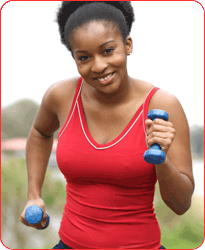SPORTS BRAS
There are two types of sports bras.
- Compression bras do exactly what the name implies. The bra compresses or flattens your breasts and limits their movement. This style works best for those women who are A or B cups. However, many women do not like the way the bra makes them look.
- Encapsulation bras are a better bet for those with larger breasts, especially if you are a C-cup or larger. This type of bra provides more support by separating each breast into a molded cup.
When shopping for a bra remember to:
- Try on several types of bras to see what you are comfortable with.
- Stick with straps that are wider and are adjustable to prevent any chafing on the shoulders as well as slippage off the shoulders.
- Choose a sports bra that fits snug, but still allows for you to catch your breath. You should be able to slightly pull the straps and bottom.
- Mimic the type of activity you will be doing. For example if you will be jogging, try jumping up and down and jogging in place.
- Choose a bra made from synthetic fibers, such that breathe and draw moisture away from the body.
CLOTHING
When choosing your clothing, it's important to dress appropriately according to the weather, and the activity you'll be performing. Make sure that whatever you choose to wear, that there is no chafing and you can move comfortably in them.
- When it's hot outside, wear loose fitting, light colored, breathable clothes, and don't forget the sunscreen. You can even choose clothing made with the special synthetic wicking material that draws the moisture away from the body.
- When it's cold outside, dress in layers so that once your body warms up you can shed the outer layer. Make sure to choose thick socks as well.
- When it's dark outside, make sure to dress in light colored clothing that have reflective materials on them.
SHOES
When choosing the right shoes, it is important to know that not all shoes are the same. Even shoes within the same category, such as walking or running, can be very different. The important thing is that you choose a shoe that gives you the proper support, flexibility, cushioning and also takes into consideration any foot problems you may have.
Account for the shape of your feet
Width and length - Make sure you shoes are wide enough for your feet, or it may lead to calluses and blisters. Also, if the toe box area is too low, it can lead to bunions and hammertoes.
Arch type - The arch is the area under your feet that provide the flexibility in movement. Most arches fall into three categories - neutral, high and low (or flat feet). To know what kind of feet you have, you can take the wet test or you can take a pair of your old shoes to a specialty running store and have a member of the staff examine your feet and the shoes.
Wet Test: Place each one of your feet in water and then place them on a surface that will leave an imprint of your foot, such as a newspaper. If the ball and heel of your foot are not joined or are joined by a narrow band, then you have a high arched foot. If they are joined by a wide band, then you have a normal foot. If they are joined by a really wide band and have little are where the arch should be, then you have a flat foot.
- High arched feet - High arches can mean above normal strain on your muscles and joints and an inability to absorb shock easily. To compensate for this, look for shoes with extra cushioning.
- Low arched feet - People with low arches have a tendency to roll your feet inward when walking. This can cause problems with you feet and knees since there is a lack of support in the feet. It is best to look for a shoe with extra support and motion control.
Tips for buying shoes
- Try on shoes at the end of the day. Your foot tends to swell later in the day and this will help ensure the correct size.
- Visit a reputable shoe store with knowledgeable salespeople. Explain your needs and what your goals are. The store representative should observe your stride and decide if your feet require a particular type of shoe. They should also measure your feet.
- Try on several pairs of shoes. Don't judge a shoe by its 'look' or price tag.
- Try shoes one-half or one size larger than your everyday shoes. When you try on a shoe, you should have about a half inch of "wiggle" room for your toes.
- Make sure your shoes are wide enough. If you have wide feet, consider men's or boy's shoes as they are cut a little bit wider.
- The back of the shoe should be firm and supportive, without slipping. When walking in the shoe, the heel should fit snugly, with plenty of cushioning.
Taking care of your shoes
All shoes eventually begin to wear out. After a while they may not be giving you the amount of support and cushioning required for your feet. There's no single standard time to replace a pair of shoes, but you can often tell that it's time to change them when you begin to experience pain in your ankles, knees, or back pain. Use this chart to keep track of the type, size, and mileage of your shoes.
| Brand of Shoe | Type of Shoe | Date Purchased | Date to Expire |
|---|---|---|---|


